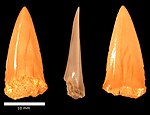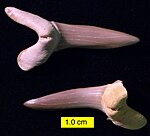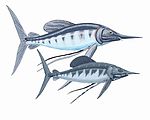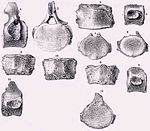| Eutaw Formation | |
|---|---|
| Stratigraphic range: Upper Cretaceous | |
| Type | Geological formation |
| Sub-units | Tombigbee Sand Member, Ingersoll Shale |
| Underlies | Austin Group and Mooreville Chalk Formation |
| Overlies | Tuscaloosa Group |
| Thickness | 40 m (130 ft) to 120 m (390 ft) |
| Lithology | |
| Primary | Glauconitic sandstone |
| Location | |
| Region | Alabama, Georgia, Mississippi |
| Country | United States |
| Type section | |
| Named for | Eutaw, Alabama |
The Eutaw Formation is a geological formation in North America, within the U.S. states of Alabama, Georgia, and Mississippi. The strata date from the late Coniacian to the early Santonian stage of the Late Cretaceous. It consists of the upper Tombigbee Sand Member and an unnamed lower member. Dinosaur, mosasaur, and pterosaur remains have been recovered from the Eutaw Formation.
Vertebrate paleofauna
Cartilaginous fish
| Cartilaginous fish of the Eutaw Formation | ||||||
|---|---|---|---|---|---|---|
| Taxa | Species | State | Stratigraphic position | Abundance | Notes | Images |
|
A. kopingensis |
A lamniform shark |
    | ||||
|
B. schwimmeri |
||||||
|
B. mcnultyi |
||||||
|
B. wichitaensis |
||||||
|
C. sp. |
A lamniform shark | |||||
|
C. globidens |
||||||
|
C. decipiens (=C. meyeri or C. saginatus?) |
||||||
|
C. greeni |
||||||
|
C. semiplicatus |
A lamniform shark | |||||
|
C. appendiculata |
||||||
|
C. serrata |
||||||
|
C. mantelli |
A lamniform shark | |||||
|
E. sp. |
A chimaera | |||||
|
H. sp. |
||||||
|
H. sp. |
||||||
|
I. mira |
A rajiform | |||||
|
Lissodus (=Lonchidion?) |
L. sp. |
|||||
|
P. angustidens |
A lamniform shark | |||||
|
P. laevis |
A lamniform shark | |||||
|
P. mcnultyi |
A rajiform | |||||
|
P. mortoni |
||||||
|
P. polygyrus |
||||||
|
P. rugosus |
||||||
|
P. triangularis (=P. vermiculata and/or P. chattahoochiensis?) |
||||||
|
Rajiformes indet. |
||||||
|
S. raphiodon |
Lamniform sharks | |||||
|
S. texanus |
||||||
|
S. sp. |
A rajiform | |||||
|
S. falcatus |
Lamniform sharks | |||||
|
S. kaupi |
||||||
|
S. pristodontus |
||||||
Bony fish
| Bony fish of the Eutaw Formation | ||||||
|---|---|---|---|---|---|---|
| Taxa | Species | State | Stratigraphic position | Abundance | Notes | Images |
|
A. dunklei |
A bonefish |
   | ||||
|
A. phaseolus |
||||||
|
A. sp.? |
A gar | |||||
|
B. sp. |
||||||
|
B. sp. |
||||||
|
E. petrosus |
An enchodontid | |||||
|
H. priscus |
||||||
|
L. sp. |
A gar | |||||
|
M. sp. |
A coelacanthiform fish | |||||
|
P. puncatatus |
||||||
|
P. sp. |
||||||
|
S. apicalis |
An aulopiform | |||||
|
X. audax |
||||||
Turtles
| Turtles of the Eutaw Formation | ||||||
|---|---|---|---|---|---|---|
| Taxa | Species | State | Stratigraphic position | Abundance | Notes | Images |
|
C. barberi |
 | |||||
|
P. gigas |
||||||
|
T. sp. |
||||||
|
T. sp. |
||||||
|
Trionychidae indet. |
||||||
Plesiosaurs
| Plesiosaurs of the Eutaw Formation | ||||||
|---|---|---|---|---|---|---|
| Taxa | Species | State | Stratigraphic position | Abundance | Notes | Images |
|
D. vetustus |
An elasmosaurid |
 | ||||
|
Elasmosauridae indet. |
||||||
Mosasaurs
| Mosasaurs of the Eutaw Formation | ||||||
|---|---|---|---|---|---|---|
| Taxa | Species | State | Stratigraphic position | Abundance | Notes | Images |
|
Clidastes sp. |
  | |||||
|
E. sternbergii |
| |||||
|
G. alabamaensis |
||||||
|
P. tympaniticus |
||||||
|
P. sp. |
||||||
|
S. russelli |
||||||
|
T. nepaeolicus |
||||||
|
T. proriger |
||||||
Crocodylians
| Crocodylians of the Eutaw Formation | ||||||
|---|---|---|---|---|---|---|
| Genus | Species | State | Stratigraphic position | Abundance | Notes | Images |
|
B. sp. |
An eusuchian |
 | ||||
|
D. rugosus? |
An alligatoroid | |||||
|
L. sp. |
An alligatoroid | |||||
Ornithodires
Dinosaur feathers have been found in the Ingersoll Shale of Georgia, which is a subunit of the Eutaw Formation. Indeterminate hadrosaurid remains have been found in Mississippi. Ornithomimosaurs of medium-size and large-size have also been unearthed in Mississippi.
| Ornithodires of the Eutaw Formation | ||||||
|---|---|---|---|---|---|---|
| Genus | Species | State | Stratigraphic position | Abundance | Notes | Images |
|
L. atopus |
A hadrosauromorph dinosaur |
  | ||||
|
Indeterminate |
A pteranodontid pterosaur | |||||
See also
References
- Liu, Kaiyu. "Facies Changes of the Eutaw Formation (Coniacian-Santonian), Onshore to Offshore, Northeastern Gulf of Mexico Area". Department of Geological Sciences. University of Alabama. Retrieved 2009-02-10.
- ^ Kiernan, Caitlin R. (2002). "Stratigraphic distribution and habitat segregation of mosasaurs in the Upper Cretaceous of western and central Alabama, with an historical review of Alabama mosasaur discoveries". Journal of Vertebrate Paleontology. 22 (1): 91–103. doi:10.1671/0272-4634(2002)022[0091:SDAHSO]2.0.CO;2. S2CID 130280406.
- ^ "Coastal Plain Geologic Province". The New Georgia Encyclopedia. Georgia Humanities Council and the University of Georgia Press. 2007-08-30. Retrieved 2009-02-10.
- ^ Kejiri, T.; Ebersole, J.A.; Blewitt, H.L.; Ebersole, S.M. (2013). "An Overview of Late Cretaceous Vertebrates from Alabama". Bulletin of the Alabama Museum of Natural History. 31 (1): 46–71.
- Bardet N, Suberbiola P, Iarochene M, Bouyahyaoui F, Bouya B, Amaghzaz M (2002). "A new species of Halisaurus from the Late Cretaceous phosphates of Morocco, and the phylogenetical relationships of the Halisaurinae (Squamata: Mosasauridae)". Zoological Journal of the Linnean Society. 143 (3): 447–472. doi:10.1111/j.1096-3642.2005.00152.x.
- Kaye, John M.; Russell, Dale A. (January 1973). "The Oldest Record of Hadrosaurian Dinosaurs in North America". Journal of Paleontology. 47 (1): 91–93. JSTOR 1302869.
- Chinzorig, Tsogtbaatar; Cullen, Thomas; Phillips, George; Rolke, Richard; Zanno, Lindsay E. (2022-03-25). "Large-bodied ornithomimosaurs inhabited Appalachia during the Late Cretaceous of North America": 2022.03.25.485782. doi:10.1101/2022.03.25.485782. S2CID 247749395.
{{cite journal}}: Cite journal requires|journal=(help)

